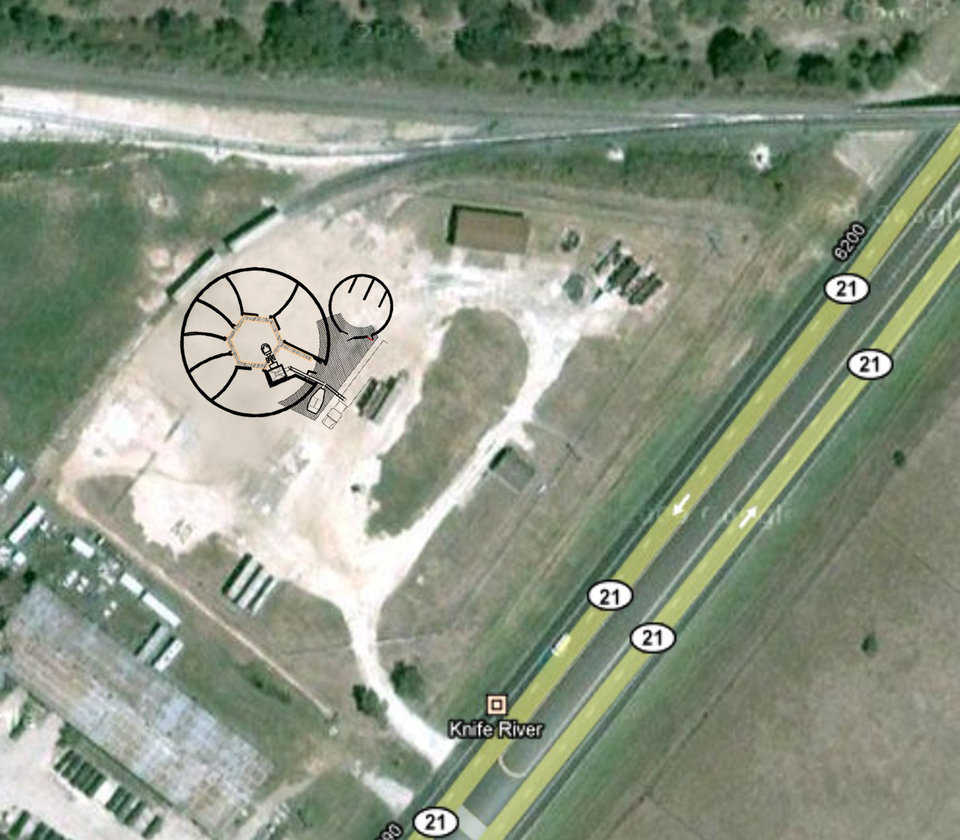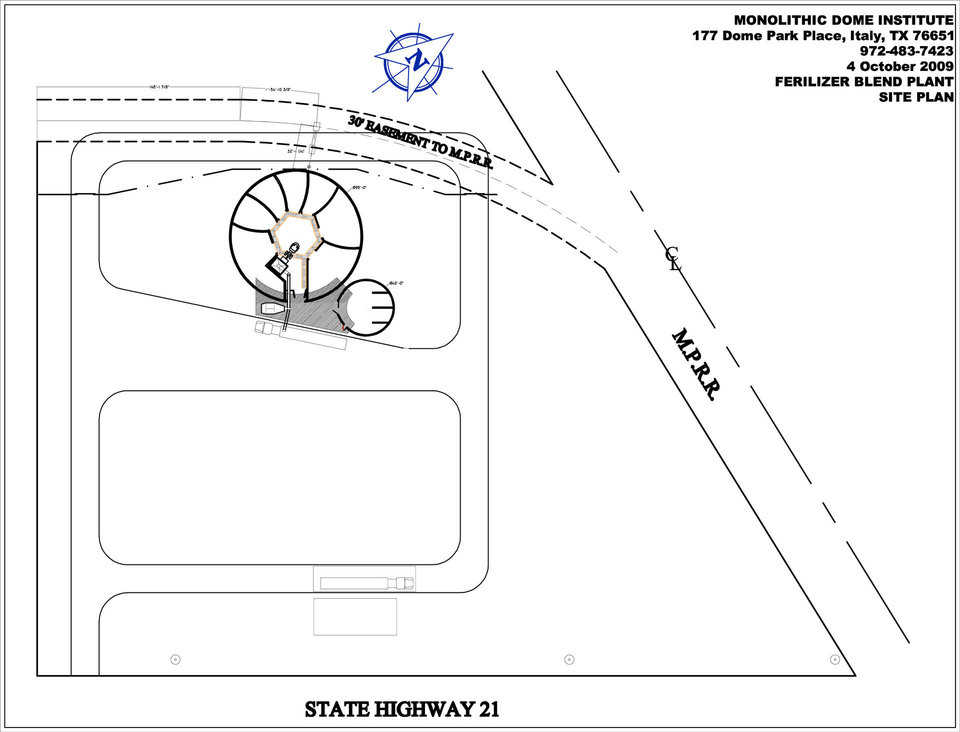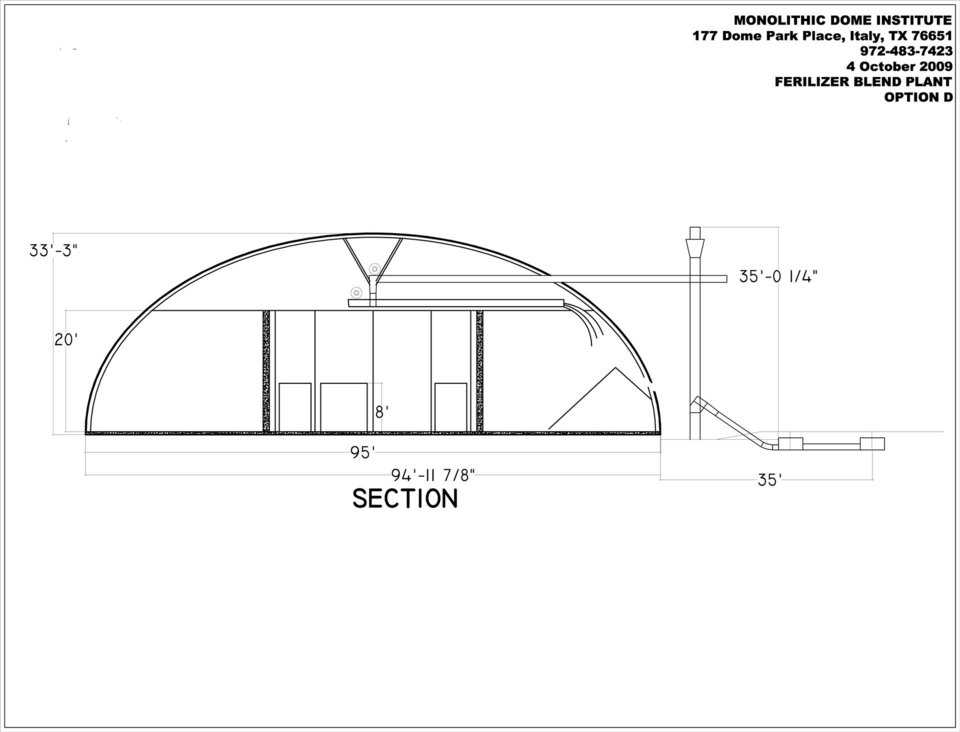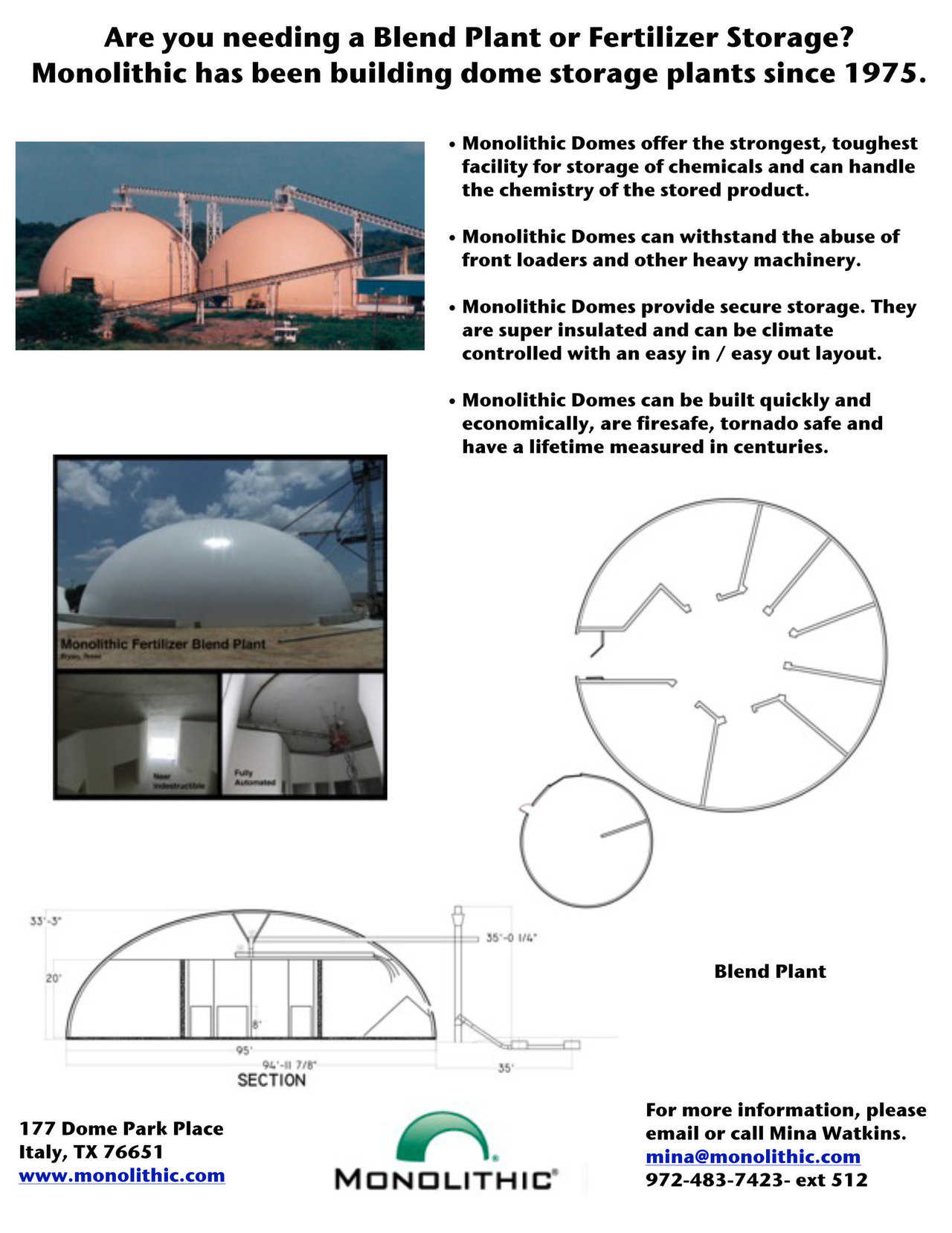El Dorado Chemical – November 2009
El Dorado Chemical has contracted with Monolithic to build their new blend plant. A blend plant is for fertilizer. The various chemicals are stored separately. They can be loaded into a blender that mixes for delivery to the farm fields. By blending the field can be fertilized specifically for the crops grown.
The plant is unique as it is in a pair of oblate ellipses connected with a work cover porch. The larger dome is 95 feet in diameter and the smaller is 40 feet in diameter. The larger has a capacity of 3000 ton in 7 bins. The smaller has 2 small bins in it for micro nutrients and miscellaneous other farm chemicals.
Their prior plant located on this same property burned last year. Having a fire safe replacement building makes sense.
The circular storage will allow much less travel time to gather the needed chemical into the weigh hopper. The chemicals are then conveyed to the exterior blender. From the blender they go to the spreader trucks or trailers.
A fertilizer blend plant
It mixes, packages, stores and distributes specialty chemicals for various agricultural purposes. Facilities contain many large bins used to store phosphorus, potash and nitrogen in various forms, as well as other micro nutrients such as iron, chrome or zinc. From these ingredients, hundreds of different fertilizer formulas can be created.
During the early 1980s, food production was on the rise in the United States. A farmer’s routine for preparing soil went something like this:
A farmer needed fertilizer for his crops. A soil sample was taken and sent to a lab. A report was then sent to the farmer specifying which nutrients needed to be added to his soil for maximum crop production. This report was taken to the nearest fertilizer blend plant. A worker put together the combination of nutrients into a blender that resembled a concrete mixer and rotated it. The customized mix was then loaded onto trucks or trailers, taken to the farm and spread.
Toward the end of the 1980s, many government farm programs meant to decrease surpluses were implemented, causing a decline in America’s food production. Therefore, the need for new blend plants diminished. Older facilities still existed, but very few new plants were built.
However by 2004, the United States began experiencing a small rise in food production, creating a need for additional fertilizer blend plants.
Monolithic Domes are the ideal structures for blend plants:
- Domes offer the strongest, toughest facility for storage of chemicals.
- Domes can handle the abuse of front loaders and other heavy machinery.
- Domes can handle the chemistry of the stored products. (There is some danger in storing ammonium nitrate.)
The first Monolithic fertilizer storage
Lincoln County Farm Center in Chandler, Oklahoma was built in 1979 as the first Monolithic Dome fertilizer storage. Owner Bill Matthews saw a small magazine ad for Monolithic Dome fertilizer storages and called David South. After several conversations, Bill decided to go to Idaho to see a dome for himself.
Bill said, “We were operating on a shoestring budget. We got into the fertilizer business under very poor circumstances in 1971. We had a big competitor in town. We tried several times to buy them out, but they never would sell to us. After learning about domes and talking to David South, I had to borrow money for a plane ticket to Idaho.”
While in Idaho, David showed several potato storages and a few houses to Bill so he could visualize a Monolithic Dome as a fertilizer storage. David assured Bill that he could build exactly what Bill wanted.
“I could tell he was an intelligent man and so I trusted him,” said Bill.
David traveled to Oklahoma to build the dome for cost plus a little more.
Bill said, “He saved me a lot of money and I provided him with the opportunity to build right off a major highway where we had a lot of lookers and some who would stop to tell us the dome would surely fall in.”
When suppliers discovered that the Lincoln County Farm Center had a fertilizer storage near Tulsa, they began making better deals with Bill.
Then OK Grain Company at the Port of Catoosa, Oklahoma heard about the domes and soon built a Monolithic Dome grain storage facility too.
Soon tug boat captains along the Mississippi, Arkansas and other rivers leading to the port began talking about the unique storage facility they saw.
So over the next few years, Monolithic built fertilizer storages all over the Midwest, on all the navigable rivers. Soon the Tom Bigbee, Missouri, Mississippi and Columbus were speckled with Monolithic Domes.
A changing market
Bill Matthew said, “Back in the 70s, we had nothing but full-time farmers coming to us. That was the market. Now, our market consists of 40-hours-a week people whose farms are secondary. What used to be one-person farming on 100 acres is now probably 10-15 people farming that same land which has been divided into smaller farm lots.”
Whether it’s 10 acres or 100, soil still needs testing but many do not. Instead, they ask a fertilizer company to guess or estimate their needs. However, according to Bill, progress is being made in convincing farmers of the benefits of soil testing.
The focus on farming has also shifted. Instead of wheat or other grains grown for human consumption, a large percentage of American grain is now grown for animal feed.
The growing demand
In closing, Bill Matthew said, “The only reason I could see NOT utilizing a blend plant, is if by some chance everyone in the same area was growing the same crop using the same soil with the same needs. However, that’s rarely the case.”
Because land has changed so much over the years, more blend plants are needed to meet the needs of the changing soil and assist farmers in adapting to those changes.
An aside:
The Lincoln County Farm Center was also the first project where Monolithic used spray-in-place construction for the bin walls. A local concrete supplier was so enthralled with this method, he spent a large amount of time watching and learning. David South remembers the man saying, “I am so excited about this new application process, that I am neglecting my own business.”
Note: We originally presented this article in April 2004. Updated November 2009

Eldorado Chemical Blend Plant — Located in Bryan, Texas the large dome is 95 feet in diameter and the smaller is 40 feet in diameter. The large dome has a 3000 ton capacity. (Javier Figueroa)

Eldorado Chemical: Rendering — This illustrates the arrangement of the bins and the overhead walkway for checking on fertilizer. Obviously the conveyor equipment is not shown. (Linda Ware)

Eldorado Chemical: Building site — This is a modified google picture showing the new blend plant located on the property. (google maps)

Eldorado Chemical: Site Map — The 5 acre property is ideal for plenty of room for the plant, an existing scale house and repair shop. The fertilizer equipment is being supplied by Adams Fertilizer Equipment – www.adamsfertequip.com.

A Significant First! — In 1979, this 75’ diameter Monolithic Dome became our first fertilizer blend plant. Monolithic constructed it for Lincoln County Farm Service in Chandler, Oklahoma.

Artist’s Rendering — This drawing shows the interior of a Monolithic Dome fertilizer blend plant.

Petersburg, Nebraska Ag Center — Crop Care & AG Supply Center in Petersburg, Nebraska.

Eldorado Chemical: Conveyor Plans — Note that the plant backs up to the railroad. The unloader will unload both the rail cars, and trucks. It is then raised by a vertical leg. It is then conveyed to the center of the larger dome where it is dropped into the rotating screw conveyor for distribution to the individual bins.
